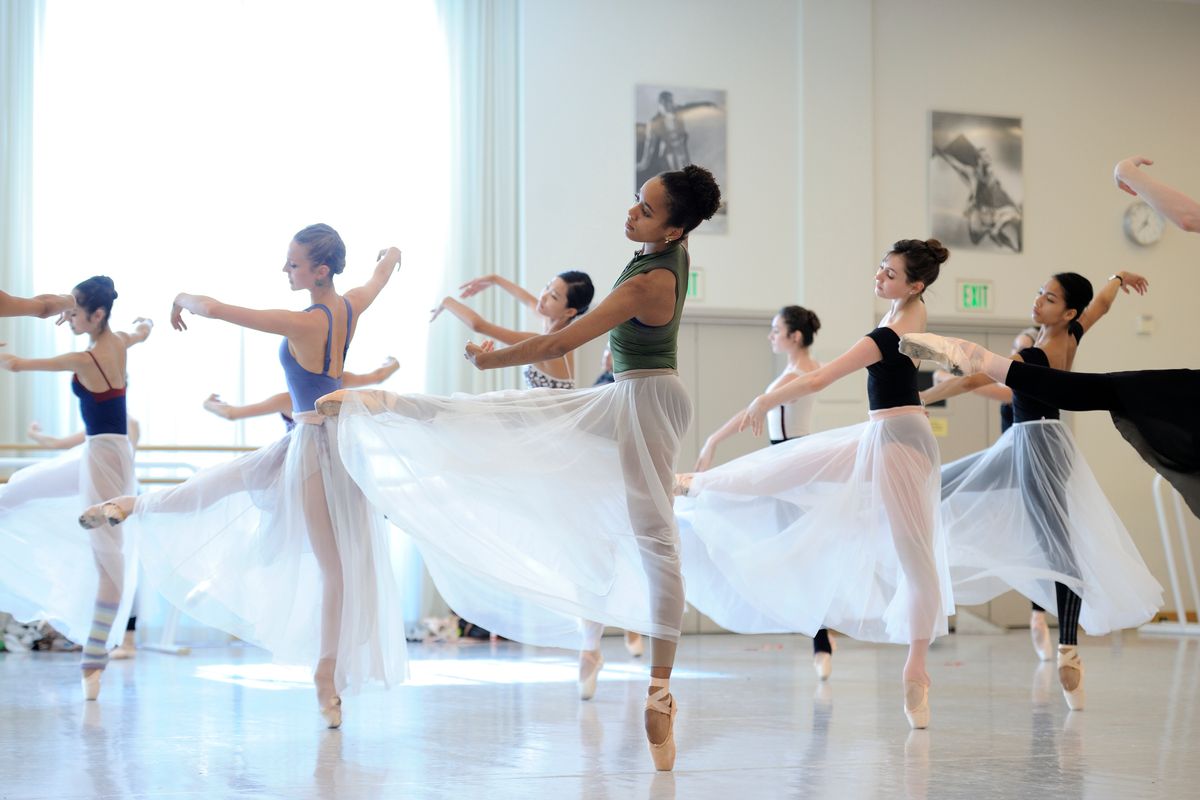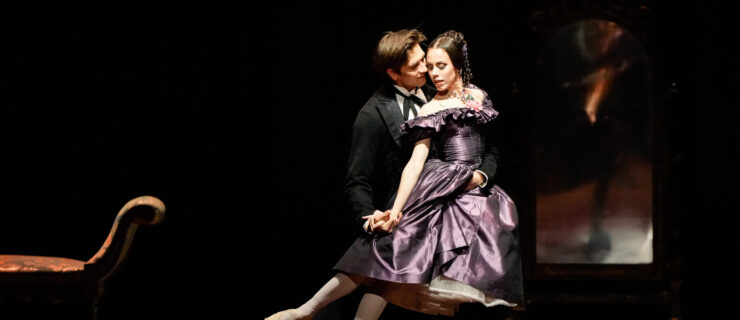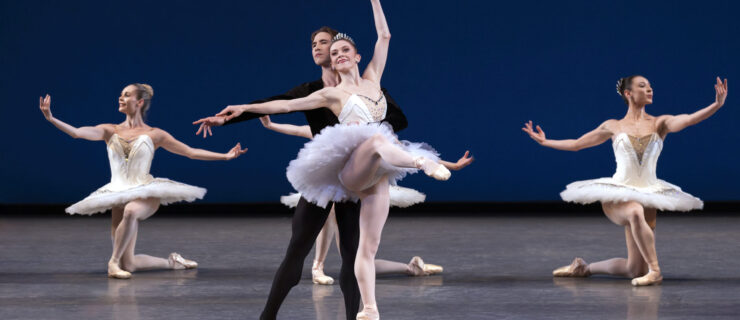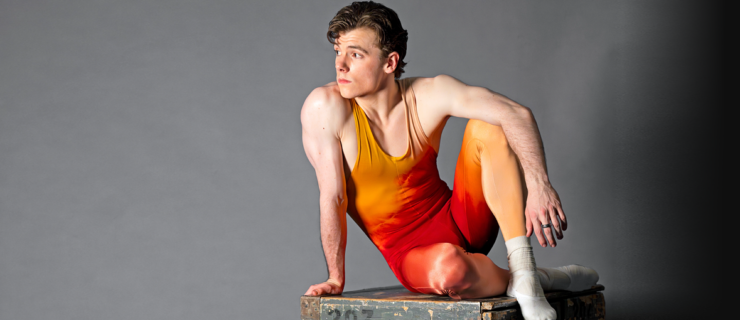Space to Grow: These 5 Dancers Share How They Stretched Themselves During Their Second Company Years
Receiving a second company or trainee contract can help bridge the gap from student to professional. Whether you make it into the main company afterwards or move on to another one, these years, if danced to the fullest, can be valuable to your life and career.
Lillian DiPiazza: Pennsylvania Ballet II → Pennsylvania Ballet

DiPiazza in Balanchine’s Tschaikovsky Pas De Deux. Photo by Alexander Izilaev, Courtesy Pennsylvania Ballet.
For Pennsylvania Ballet principal dancer Lillian DiPiazza, the path to lead roles began during her year with Pennsylvania Ballet II. “You still get a lot of personal attention, unlike being an apprentice or corps member, where it is easy to get lost,” says DiPiazza. “Getting individual coaching and performing in front of smaller school audiences helped me get stronger and more comfortable in terms of performance.” She also cut her teeth with the main company in Twyla Tharp’s Push Comes to Shove and Balanchine’s Ballo della Regina. DiPiazza has fond memories of adjusting to living on her own, too (which include getting locked in the bathroom and calling the fire department for help).
It wasn’t always easy. “Even though the company wanted to use us, we had to be in second company rehearsals, too. Sometimes you felt behind,” she remembers. Though she was often cast in Pennsylvania Ballet productions, DiPiazza had anxiety about getting into the company—which made the day she received her apprentice contract all that much sweeter.
The takeaway: “Don’t limit yourself,” says DiPiazza. “People come in from the outside and you can learn something from them. Who knows? They might want to use you, and it can help you move up the ranks if choreographers want to work with you.”
Alice Klock: Hubbard Street 2 → Hubbard Street Dance Chicago

Klock with Jonathan Fredrickson in Jiří Kylián’s Petite Mort. Photo by Todd Rosenberg, Courtesy Hubbard Street Dance Chicago.
“Most of my training before college was very classical,” says Alice Klock, who attended the Alonzo King LINES Ballet BFA program at Dominican University of California. “But the LINES experience made me want to branch out more.” After two years of college, she attended Hubbard Street Dance Chicago’s summer program as an audition for the second company and got in. Klock spent much of the first year retraining her body to better understand the basics of contemporary styles, focusing on expansion and checking her demure, polite presentation at the stage door. “Performance expectations were different,” she says. “I learned how to be rawer, more human, by watching the company so closely.”
She still remembers her first performance with Hubbard Street 2, at the Art Institute of Chicago. “It was an installation piece, and through a big glass ceiling, you could see stars,” says Klock. “I thought, ‘Wow, this is my life now,’ and I will never forget that magic.” After two years, there wasn’t a company spot available for her, so she signed on for a third year with mixed feelings. However, someone dropped out last-minute, and she received her main company contract after all.
The takeaway: “I learned about the demeanor of a productive, professional dancer,” says Klock. “Never lose your ability to listen, use your time well, and treat everyone with kindness.”
Erica Alvarado: Milwaukee Ballet II → City Ballet of San Diego → Atlanta Ballet

Alvarado as Kitri in Don Quixote. Photo by Kim Kenney, Courtesy Atlanta Ballet.
This past February, Erica Alvarado was first cast in the role of Kitri for her inaugural season with Atlanta Ballet. But her path to such a triumph has been anything but linear. She spent two years in Milwaukee Ballet II at the start of her career, hoping to join the main company. Because MBII often performs outreach programs at area schools, her days sometimes began as early as 7 am. From there, it was back to the studio for a full day of rehearsals. “Getting in the groove of that was the first step,” she says. While she received a stipend, Alvarado had to rely on financial support from her parents to make ends meet.
Her second year, the pressure was on to be hired into the main company. “It was nerve-racking,” remembers Alvarado. “We had to wait until the company dancers received their letters of intent, and it was all about timing and which spots were available. But that’s so hard to accept when you’re young.” Though she didn’t receive an apprenticeship at Milwaukee Ballet, she auditioned elsewhere and was offered a full company contract at City Ballet of San Diego, where she danced for six seasons before joining Atlanta Ballet.
The takeaway: No matter the outcome, use this experience to your advantage. “Don’t be bummed if you have to go through a second company. That is how you get performance experience and get to know yourself as a technician and artist,” says Alvarado.
Hitomi Nakamura: Orlando Ballet II → Orlando Ballet

Nakamura in Nutcracker. Photo by Michael Cairns, Courtesy Orlando Ballet.
When Hitomi Nakamura went to Orlando Ballet’s summer intensive as an audition for Orlando Ballet II, the stakes couldn’t have been higher. “I was at Houston Ballet Academy and had no place to go for the next season,” says Nakamura, who is Japanese. “The only way for me to keep dancing in the States was to get into OB II.” To her relief, she was hired at the end of the summer.
Nakamura found her time in the second company went by quickly, as they worked Monday through Saturday with both the school and the company. Though standing on the side of company rehearsals for long hours could be frustrating, the balance of performing corps roles with Orlando Ballet and principal roles with the school made it all worth it. She was even able to compete at the 2014 USA IBC in Jackson, Mississippi. “I had time to practice since I wasn’t in the main company yet,” says Nakamura. After a year of exhausting work and scraping by with four roommates, she received a full company contract.
The takeaway: “In a normal audition you have one class to show yourself,” says Nakamura. “But in a second company you have many opportunities to show yourself. Even if you think you’re not seen, people are watching, so give yourself to the role, no matter how small, 100 percent.”
Miranda Silveira: San Francisco Ballet Trainee Program → San Francisco Ballet

Silveira in performance with San Francisco Ballet. Photo by Erik Tomasson, Courtesy SFB.
Miranda Silveira came to San Francisco Ballet School’s trainee program from her native Spain on a scholarship, ready for a challenge. “Being a trainee was the perfect way to be introduced to what life is like as a pro,” says Silveira. “Whenever I worked with the company, it was such an honor. I never thought twice about being at the bottom.”
In addition to close proximity to some of the world’s greatest dancers, Silveira made lifelong friends. “All the people who did the program with me are close to my heart,” she says. “We did our own performances around the Bay Area—dance field trips—on challenging stages. It was a hard year, but we did it together.
That spring, SFB artistic director Helgi Tomasson came to watch classes, rehearsals and community performances. Though Silveira had auditioned elsewhere to be on the safe side, she landed an apprentice contract and has now made her way into the corps.
The takeaway: “Show your interest and don’t be afraid to talk to your superiors,” says Silveira. Meetings with the principal of SFB’s trainee program helped her track her progress, get questions answered and chart her path. “Communication is really a good thing. Just be sure to choose the right time and be respectful.”





